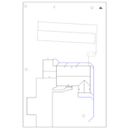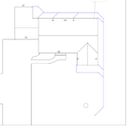Downspout and drainage retrofit
Introduction
Like many others our home sustains a tremendous fight against rain and ground water. The basement was retrofitted many years ago with a perimeter drain and sump pump. The sump pump mainly runs during February, March and April but recently turned on since remnants of Hurricane Florence, beginning September 20th, 2018.
Root Cause
The topography of the site sits lower than the 3 adjacent properties and doesn’t allow surface rain water to flow away from the backyard and leach field. I think the home and septic system should’ve been built 2ft higher than it’s original site plan.
Present Problems
1. 3 rear downspouts drain directly into back yard near foundation causing water to fill basement window basins and overflow into basement.
2. Sump pump discharges onto backyard and into leach field
Restraints
1. If we divert the water away from the foundation the water will flow directly into the leach field, flooding the leach field.
2. A great big pine is located south of the garage, left side of the home. It’s roots stretch towards the garage and into the back yard. I understand it’s safe practice never to cut the roots of a large tree neighboring adjacent properties. Approx. 5 4″ diameter roots lay perpendicular where we’d need to dig underneath for pipe drainage.
Temporary Solutions
1. This Spring we quickly laid solid corrugated piping diverting 2 rear downspouts towards the front yard, 10ft from the road.
2. We also lengthened the sump pump hose from 10ft to 60ft, wrapping the hose around the home towards the front yard
Proposal
We created a drainage plan diverting 5 of the 7 downspouts and 1 sump pump discharge towards the front yard. I’d like to attach the downspouts directly into the pipe via 90 degree elbows and Wye’s. Distance between grass and top of pipe approx. 4″.
Concerns
1. The 4″ pipe might be too narrow for heavy rain storms however if the system works 90% of the time I think it’s successful.
2. We’re located in Massachusetts and freezing temperatures make me ask if attaching the downspouts directly into the pipe is okay.
Any criticism and advice is welcome.
GBA Detail Library
A collection of one thousand construction details organized by climate and house part











Replies
Justin,
1. Switch from 4-inch pipe to 6-inch pipe.
2. If the drain pipe has a steady downhill slope, without flat sections, you don't have to worry too much about freezing -- burying the pipe 6 inches or 12 inches deep may be enough.
3. A good method is to install a plastic catch basin (see photo below) -- you have to bury it -- directly under each downspout, and then install 6-inch-diameter plastic pipe from the catch basin to the discharge point.
Thanks Martin,
1. It appears ADS offers a smooth wall 6" pipe but not 6" triple wall. Should this be a concern?
https://www.ads-pipe.com/products/pipes/ads-triple-wall-smoothwall
2. I believe we have enough grade to slope each 10' section 0.5" from 0" to 10'.
3. The catch basin confuses me. I saw this image posted by Structure Tech Home Inspections.
Wouldn't it make more sense to insert the downspout directly into the drainage pipe, avoiding overflow and freeze up?
The larger 6 inch pipe and catch basins will make it easier to maintain your drainage system. (I had 4 inch in-ground drains on one house, and they were always developing clogs.)
Gutters have a way of filling up with leaves, twigs, and other debris, and a lot of that stuff can move into your downspouts and in-ground drains.
Hey everyone,
It's been 1 year since we installed the drainage pipe and I wanted to share some results.
Pipe diameter: We've had a many heavy rains but the 4" pipe seems to handle the rain load. We've seen no overflowing or freezing around the drainage entry points.
Catch basins: Martin and many others recommend installing catch basins but we inserted the downspouts directly into the drain entry ports. The intent was to maintain the gravitational momentum of the water without creating backsplash. Since one winter we saw no signs of freezing.
Number of pipes: We almost considered separating the rear and front downspouts into 2 pipes. Meaning the pipes would run parallel to one another under the ground. This didn't seem necessary. The single pipe seems to carry the load.
Corrugated or non-corrugated: Non corrugated pipe is slightly more expensive but I find it easier to work with. It reminds me of the copper pipe vs PEX pipe challenge. PEX pipe is a floppy noodle and requires many fastening brackets to keep it secure. I can't imagine terminating a shower valve with PEX pipe and the shower valve remaining rigid and secure.
The rigid drainage pipe seemed much easier to maintain a gradual pitch. The smooth interior surface won't collect roof shingle sand or other debris. I suppose catch basins would prevent that but we didn't want to restrict the momentum of the water. For me this aspect is the most important when addressing possible blockage and entry freezing. All joints were sealed using silicone caulking. If we need to modify or repair we can easily do so by rotating and pulling the fittings.
Some more pictures.
Justin,
Thanks for the update. For a long litany of good reasons Big O is no longer allowed under our code for either perimeter or storm drains.
As a side note: I take your point about how floppy corrugated pipe is, but shower valves get directly connected to Pex all the time. The valve is designed to be mounted to blocking. Relying on the surrounding copper pipes for rigidity isn't a good idea.